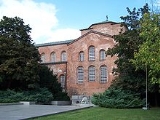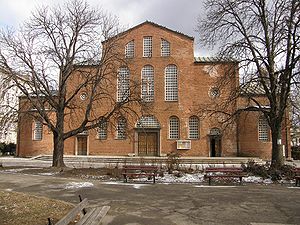
Church of St Sophia, Sofia
Encyclopedia

Bulgaria
Bulgaria , officially the Republic of Bulgaria , is a parliamentary democracy within a unitary constitutional republic in Southeast Europe. The country borders Romania to the north, Serbia and Macedonia to the west, Greece and Turkey to the south, as well as the Black Sea to the east...
n capital Sofia
Sofia
Sofia is the capital and largest city of Bulgaria and the 12th largest city in the European Union with a population of 1.27 million people. It is located in western Bulgaria, at the foot of Mount Vitosha and approximately at the centre of the Balkan Peninsula.Prehistoric settlements were excavated...
, dating to the 6th century. In the 14th century, the church gave its name to the city, previously known as Sredets (Средец).
The church was built on the site of several earlier churches and places of worship dating back to the days when it was the necropolis of the Roman
Ancient Rome
Ancient Rome was a thriving civilization that grew on the Italian Peninsula as early as the 8th century BC. Located along the Mediterranean Sea and centered on the city of Rome, it expanded to one of the largest empires in the ancient world....
town of Serdica. In the 2nd century, it was the location of a Roman theatre. Over the next few centuries, several other churches were constructed, only to be destroyed by invading forces such as the Goths
Goths
The Goths were an East Germanic tribe of Scandinavian origin whose two branches, the Visigoths and the Ostrogoths, played an important role in the fall of the Roman Empire and the emergence of Medieval Europe....
and the Huns
Huns
The Huns were a group of nomadic people who, appearing from east of the Volga River, migrated into Europe c. AD 370 and established the vast Hunnic Empire there. Since de Guignes linked them with the Xiongnu, who had been northern neighbours of China 300 years prior to the emergence of the Huns,...
. The basic cross design of the present basilica, with its two east towers and one tower-cupola, is believed to be the fifth structure to be constructed on the site and was built during the reign of Byzantine Emperor Justinian I
Justinian I
Justinian I ; , ; 483– 13 or 14 November 565), commonly known as Justinian the Great, was Byzantine Emperor from 527 to 565. During his reign, Justinian sought to revive the Empire's greatness and reconquer the lost western half of the classical Roman Empire.One of the most important figures of...
in the middle of the 6th century (527-565). It is thus a contemporary of the better-known Hagia Sophia
Hagia Sophia
Hagia Sophia is a former Orthodox patriarchal basilica, later a mosque, and now a museum in Istanbul, Turkey...
church in Constantinople
Constantinople
Constantinople was the capital of the Roman, Eastern Roman, Byzantine, Latin, and Ottoman Empires. Throughout most of the Middle Ages, Constantinople was Europe's largest and wealthiest city.-Names:...
.
During the Second Bulgarian Empire
Second Bulgarian Empire
The Second Bulgarian Empire was a medieval Bulgarian state which existed between 1185 and 1396 . A successor of the First Bulgarian Empire, it reached the peak of its power under Kaloyan and Ivan Asen II before gradually being conquered by the Ottomans in the late 14th-early 15th century...
(spanning the 12th to 14th centuries), the structure acquired the status of a metropolitan
Metropolitan bishop
In Christian churches with episcopal polity, the rank of metropolitan bishop, or simply metropolitan, pertains to the diocesan bishop or archbishop of a metropolis; that is, the chief city of a historical Roman province, ecclesiastical province, or regional capital.Before the establishment of...
church. In the 14th century, the church gave its name to the city (Hagia Sophia meaning "holy wisdom" in Greek
Greek language
Greek is an independent branch of the Indo-European family of languages. Native to the southern Balkans, it has the longest documented history of any Indo-European language, spanning 34 centuries of written records. Its writing system has been the Greek alphabet for the majority of its history;...
). In the 16th century, during Ottoman rule, the church was converted into a mosque: the original 12th-century frescoes were destroyed and minarets were added. In the 19th century two earthquakes destroyed one of the minarets and the mosque was abandoned. Restoration work was begun after 1900.
The Hagia Sophia Church is now one of the most valuable pieces of Early architecture in Southeastern Europe. The present building is a cross basilica with three altars. The floor of the church is covered with complex Early Christian ornamental or flora and fauna-themed mosaics. The Hagia Sophia Church stands in the middle of an ancient necropolis and many tombs have been unearthed both under and near the church. Some of the tombs even feature frescoes.
According to popular lore, St Sophia's miraculous powers protected the building over the centuries, warding off human invasions and natural disasters to keep the church as an example of the elegant, austere, and symmetrical architecture of the age.
Because St. Sophia represents divine wisdom rather than a historical saint, icons within the church depict Sophia as a woman standing above three other women representing faith, hope, and love
Theological virtues
Theological virtues - in theology and Christian philosophy, are the character qualities associated with salvation, resulting from the grace of God, which enlightens human mind.- In the Bible :The three theological virtues are:...
. The church also displays icons of historical saints, including St. George
Saint George
Saint George was, according to tradition, a Roman soldier from Syria Palaestina and a priest in the Guard of Diocletian, who is venerated as a Christian martyr. In hagiography Saint George is one of the most venerated saints in the Catholic , Anglican, Eastern Orthodox, and the Oriental Orthodox...
and St. Vladimir
Vladimir I of Kiev
Vladimir Sviatoslavich the Great Old East Slavic: Володимѣръ Свѧтославичь Old Norse as Valdamarr Sveinaldsson, , Vladimir, , Volodymyr, was a grand prince of Kiev, ruler of Kievan Rus' in .Vladimir's father was the prince Sviatoslav of the Rurik dynasty...
.

